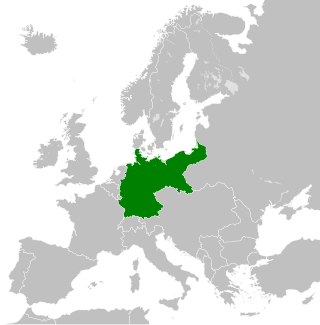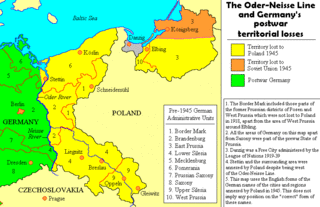
Central Europe is an area of Europe between Western Europe and Eastern Europe, based on a common geography, historical, social and cultural identity. The concept of "Central Europe" appeared in the 19th century.

The Cold War (1948–1953) is the period within the Cold War from the incapacitation of the Allied Control Council in 1948 to the conclusion of the Korean War in 1953.

Western Europe is the western region of Europe. The region's extent varies depending on context.

Eastern Europe is a subregion of the European continent. As a largely ambiguous term, it has a wide range of geopolitical, geographical, ethnic, cultural, and socio-economic connotations. The vast majority of the region is covered by Russia, which spans roughly 40% of the continent's landmass while accounting for approximately 15% of its total population.

The Yalta Conference, also known as the Crimea Conference, held 4–11 February 1945, was the World War II meeting of the heads of government of the United States, the United Kingdom and the Soviet Union to discuss the postwar reorganization of Germany and Europe. The three states were represented by President Franklin D. Roosevelt, Prime Minister Winston Churchill, and General Secretary Joseph Stalin, respectively. The conference was held near Yalta in Crimea, Soviet Union, within the Livadia, Yusupov, and Vorontsov palaces.

The Second World is a term originating during the Cold War for the industrial socialist states that were under the influence of the Soviet Union. In the first two decades following World War II, 19 communist states emerged; all of these were at least originally within the Soviet sphere of influence, though some broke with Moscow and developed their own path of socialism while retaining Communist governments. Most communist states remained part of the Eastern Bloc until the dissolution of the Soviet Union in 1991; afterwards, only five communist states remained: China, Cuba, Laos, North Korea, and Vietnam. Along with "First World" and "Third World", the term was used to divide the states of Earth into three broad categories.

The Cold War was a period of geopolitical tension between the United States and the Soviet Union and their respective allies, the Western Bloc and the Eastern Bloc. The term cold war is used because there was no large-scale fighting directly between the two superpowers, but they each supported opposing sides in major regional conflicts known as proxy wars. The conflict was based on the ideological and geopolitical struggle for global influence by these two superpowers, following their temporary alliance and victory against Nazi Germany and Imperial Japan in 1945. Aside from the nuclear arsenal development and conventional military deployment, the struggle for dominance was expressed via indirect means such as psychological warfare, propaganda campaigns, espionage, far-reaching embargoes, rivalry at sports events, and technological competitions such as the Space Race.

The Polish People's Republic was a country in Central Europe that existed from 1947 to 1989 as the predecessor of the modern Republic of Poland. With a population of approximately 37.9 million near the end of its existence, it was the second most-populous communist and Eastern Bloc country in Europe. A unitary state with a Marxist–Leninist government, it was also one of the main signatories of the Warsaw Pact alliance. The largest city and official capital since 1947 was Warsaw, followed by the industrial city of Łódź and cultural city of Kraków. The country was bordered by the Baltic Sea to the north, the Soviet Union to the east, Czechoslovakia to the south, and East Germany to the west.
Nazism and the acts of Nazi Germany affected many countries, communities, and people before, during and after World War II. Nazi Germany's attempt to exterminate several groups viewed as subhuman by Nazi ideology was eventually stopped by the combined efforts of the wartime Allies headed by the United Kingdom, the Soviet Union, and the United States.

The Cold War originated in the breakdown of relations between the two main victors in World War II: United States and the Soviet Union, and their respective allies, the Western Bloc and the Eastern Bloc, in the years 1945–1949.

Western betrayal is the view that the United Kingdom, France, and sometimes the United States failed to meet their legal, diplomatic, military, and moral obligations with respect to the Czechoslovak and Polish states during the prelude to and aftermath of World War II. It also sometimes refers to the treatment of other Central and Eastern European states at the time.

After the Russian Revolution, in which the Bolsheviks took over parts of the collapsing Russian Empire in 1918, they faced enormous odds against the German Empire and eventually negotiated terms to pull out of World War I. They then went to war against the White movement, pro-independence movements, rebellious peasants, former supporters, anarchists and foreign interventionists in the bitter civil war. They set up the Soviet Union in 1922 with Vladimir Lenin in charge. At first, it was treated as an unrecognized pariah state because of its repudiating of tsarist debts and threats to destroy capitalism at home and around the world. By 1922, Moscow had repudiated the goal of world revolution, and sought diplomatic recognition and friendly trade relations with the capitalist world, starting with Britain and Germany. Finally in 1933, the United States gave recognition. Trade and technical help from Germany and the United States arrived in the late 1920s. After Lenin died in 1924, Joseph Stalin, became leader. He transformed the country in the 1930s into an industrial and military power. It strongly opposed Nazi Germany until August 1939, when it suddenly came to friendly terms with Berlin in the Molotov–Ribbentrop Pact. Moscow and Berlin by agreement invaded and partitioned Poland and the Baltic states. Stalin ignored repeated warnings that Hitler planned to invade. He was caught by surprise in June 1941 when Nazi Germany invaded the Soviet Union. The Soviet forces nearly collapsed as the Germans reached the outskirts of Leningrad and Moscow. However, the Soviet Union proved strong enough to defeat Nazi Germany, with help from its key World War II allies, Britain and the United States. The Soviet army occupied most of Eastern Europe and increasingly controlled the governments.
Two global superpowers, the Soviet Union (USSR) and the United States (US), rose in the aftermath of World War II. The war's aftermath was also defined by the rising threat of nuclear warfare, the creation and implementation of the United Nations as an intergovernmental organization, and the decolonization of Asia and Africa by European and east Asian powers, most notably by the United Kingdom, France, and Japan.

The territorial evolution of Germany in this article include all changes in the modern territory of Germany from its unification making it a country on 1 January 1871 to the present although the history of "Germany" as a territorial polity concept and the history of the ethnic Germans are much longer and much more complex. Modern Germany was formed when the Kingdom of Prussia unified most of the German states, with the typical exception of multi-ethnic Austria where was ruled by German-speaking royal family of Habsburg and had a significant German-speaking land, into the German Empire. After the First World War, on 10 January 1920, Germany lost about 10% of its territory to its neighbours, and the Weimar Republic was formed 2 days before this war was over. This republic included territories to the east of today's German borders.
Contemporary history, in English-language historiography, is a subset of modern history that describes the historical period from approximately 1945 to the present. Contemporary history is either a subset of the late modern period, or it is one of the three major subsets of modern history, alongside the early modern period and the late modern period. In the social sciences, contemporary history is also continuous with, and related to, the rise of postmodernity.

Austria was occupied by the Allies and declared independence from Nazi Germany on 27 April 1945, as a result of the Vienna Offensive and ended with the Austrian State Treaty on 27 July 1955.

The Iron Curtain was the political boundary dividing Europe into two separate areas from the end of World War II in 1945 until the end of the Cold War in 1991. The term symbolizes the efforts by the Soviet Union (USSR) to block itself and its satellite states from open contact with the West, its allies and neutral states. On the east side of the Iron Curtain were the countries that were connected to or influenced by the Soviet Union, while on the west side were the countries that were NATO members, or connected to or influenced by the United States; or nominally neutral. Separate international economic and military alliances were developed on each side of the Iron Curtain. It later became a term for the 7,000-kilometre-long (4,300 mi) physical barrier of fences, walls, minefields, and watchtowers that divided the "east" and "west". The Berlin Wall was also part of this physical barrier.

Eastern Bloc media and propaganda was controlled directly by each country's communist party, which controlled the state media, censorship and propaganda organs. State and party ownership of print, television and radio media served as an important manner in which to control information and society in light of Eastern Bloc leaderships viewing even marginal groups of opposition intellectuals as a potential threat to the bases underlying communist power therein.

The Oder–Neisse line is an unofficial term for the modern border between Germany and Poland. The line generally follows the Oder and Lusatian Neisse rivers, meeting the Baltic Sea in the north. A small portion of Polish territory does fall west of the line, including the cities of Szczecin and Świnoujście.

The Cold War from 1947 to 1948 is the period within the Cold War from the Truman Doctrine in 1947 to the incapacitation of the Allied Control Council in 1948. The Cold War emerged in Europe a few years after the successful US–USSR–UK coalition won World War II in Europe, and extended to 1989–91. It took place worldwide, but it had a partially different timing outside Europe. Some conflicts between the West and the USSR appeared earlier. In 1945–46 the US and UK strongly protested Soviet political takeover efforts in Eastern Europe and Iran, while the hunt for Soviet spies made the tensions more visible. However, historians emphasize the decisive break between the US–UK and the USSR came in 1947–48 over such issues as the Truman Doctrine, the Marshall Plan and the breakdown of cooperation in governing occupied Germany by the Allied Control Council. In 1947, Bernard Baruch, the multimillionaire financier and adviser to presidents from Woodrow Wilson to Harry S. Truman, coined the term "Cold War" to describe the increasingly chilly relations between three World War II Allies: the United States and British Empire together with the Soviet Union.













